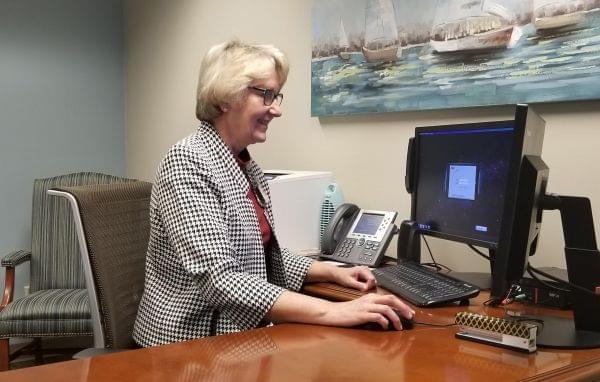How To Get Hospitals To Check A Patient’s Drug History? Make It Easy.

Dr. Gina Huhnke in her office at Midtown Deaconess Hospital in Evansville, Indiana. Samantha Horton/Side Effects Public Media
Doctors move fast in the ER. Every second counts. That’s why Dr. Gina Huhnke is excited about a new way to quickly check her patients’ history with narcotics. She’s the emergency department director of Deaconess Midtown Hospital in Evansville.
She explained how easy it is during a recent emergency room shift.
“I would open up the electronic medical record, open up the patient’s chart and then all I would have to do is click on this button in the upper left-hand corner,” she said. “It takes literally three to five seconds to receive all this information.”
Huhnke was using a new interface that lets her access Indiana’s INSPECT database—the state’s prescription drug monitoring program—directly from the hospitals electronic medical records.
It’s a new solution that Indiana is hoping to roll out in health care systems around the state to make it more likely that doctors check these systems.
Experts have blamed doctors for contributing to the nation’s opioid addiction problem by prescribing opioid painkillers too freely. To prevent over-prescription and so-called “doctor shopping” by patients with addiction, states have set up online databases to track a person’s prescription history. But the systems are often awkward and time-consuming to use.
Now, with an integrated system like the one at Deaconess, doctors can quickly see a list of previous controlled substance prescriptions and an overdose “risk score” — all the data is now accessible within a patient’s electronic health records.
It used to take minutes to look up this same data in a separate database with a separate log in — ages in ER time.
“When there are more important tasks to perform, than that might be left undone,” she said.
She said in the past, doctors often had to make an educated guess if a patient might be struggling with addiction. With the new integrated system, she can check with just a click of a button. The button is part of the NarxCare platform, the interface that connects INSPECT to the hospital’s system. Huhnke said these days, she’s checking every patient she sees.
“Prior to sending a patient home with a prescription for controlled substance, I click on that NarxCare button every single time. And it has changed my prescribing habits,” she said.
Indiana’s INSPECT Drug Monitoring Program was started in the 90s as a tool for law enforcement. In 2007, the information was made available for health providers too. But many doctors haven’t been using it because it’s time-consuming. Recent data from the Indiana Prosecuting Attorneys Council shows only about close to 50 percent of health care providers are registered with INSPECT.
This past year, Deaconess became the first hospital system in state to integrate INSPECT into its electronic health records, part of a plan Indiana Gov. Eric Holcomb announced the state plans to work with Appriss to integrate INSPECT data into hospitals statewide.
Indiana University Health Policy researcher Dr. Chris Harle said this expansion could be tricky, since different hospitals use different platforms to view electronic records.
“They will have to go and connect to each individual health system independently,” he said. “And they’ll do that through standardized technologies which will make it easier, but I do expect it will take some time.”
There are still questions if more can be done to improve the INSPECT system. Under Indiana state law, doctors are not required to check a patient's prescription record before prescribing medicine, even though it’s considered best practice.
Harle said getting doctors to voluntarily change their habits and use the prescription drug monitoring program is challenging.
“We’re trying to change providers behavior,” he said. “We’re trying to drive up use of the PDMP and drive up an accurate interpretation of the PDMP reports, and changing people’s behavior is hard.”
Huhnke believes when it’s used, INSPECT is a valuable tool because it gives providers the information they need to talk to patients about signs of addiction.
“When you’re talking with them and telling them, ‘we don’t want to prescribe medication to you today because you’ve already been prescribed too much and we’re concerned about you,’ it makes it much more impactful,” she said.
The state has said it hopes the data can be integrated into state EHRs within three years.
A more accessible system could help doctors avoid prescribing to patients with addiction. Evansville resident Logan Will is recovering from an opioid addiction he struggled with for ten years. It started with a prescription of hydrocodone for back and shoulder pain.
He said after he became addicted, he “shopped” for doctors who gave him the prescriptions he wanted.
“In the beginning, it was wherever my insurance took me, but if I’d failed with that, I’d just basically say I didn’t like the provider,” he said. “And so at the point, I was trying to see whatever doctor was going to prescribe it.”
And experts warn even the most effective drug monitoring program is just one piece of fixing a nationwide problem. Now in recovery, Logan Will wishes doctors could do more to warn patients of the risks of pain medications.
“I feel like doctors should pass [on] more in the beginning, of the dangers in it; you know like what are getting into going long-term on these medications,” he said.
This story was produced by Side Effects Public Media, a reporting collaborative focused on public health.
Links
- Trump Administration Moves To Alter Drug Discount Program That Many Rural Hospitals Rely On
- In One Ohio County, Police Try Something Different: Door-to-Door Interventions For Drug Users
- To Fight Drug Addiction, Hospitals Hire Recovering Addicts
- Helping Children of Drug-Addicted Mothers
- Doctors Say Telemedicine Can’t Replace In Person Addiction Care
- Task Force Searches For Solutions To Opioid Addiction
